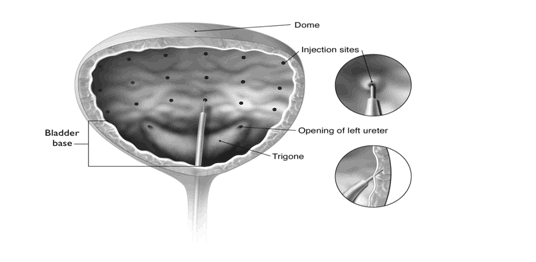Botox or Botulinum Type-A is toxin developed by bacteria known as Clostridium Botulinum. It was injected intravesically (into the bladder) for muscle over the activity. Botox acts as binding to the nerve endings of muscles and jamming the release of chemicals that may cause the muscle contraction. Most of the patients, both male and female, are appropriate for intravesical botox injections. Many patients initially they will have pressure testing on the bladder called as urodynamics. This will identify if the bladder contracts when the patient don’t want it. If this may occurs the bladder won’t store urine easily. It is a successful treatment for patients who are having a strong urge of urination, which may severely affect the quality of life. Patients may often associated with urine leakage if they won’t reach the toilet in the time. Usually called as the Overactive Bladder Syndrome (OAB) the primary treatment is with associated with lifestyle advice, physiotherapy, medication and bladder training.

PROCEDURE:
-
Initially patients will be performed either have a general or local anaesthetic.
-
The treatment takes nearly 20-30 minutes. In this doctor will uses a special telescope to examine the bladder- this is called a cystoscope.
-
The telescope was passed from the urethra into the bladder. The bladders was then examined cautiously and then inject the Botox into the bladder wall with the help of a special needle passed through the telescope.
-
The common side effects of intravesical botox injections are rarely there will be a mild bleeding, infection or pain and the lack of ability to pass urine. This occurs in 10 in 20 patients.
-
Most of the patients will be trained in self catheterisation before to the procedure to give them the confidence that they can conquer this problem.
-
Whilst Botox injections decrease the severity, frequency and urgency of urge incontinence in most of the patients, some patients won’t get any relief of the symptoms. Some patients, even though very rarely, report the symptoms are worse after taking the injections.

